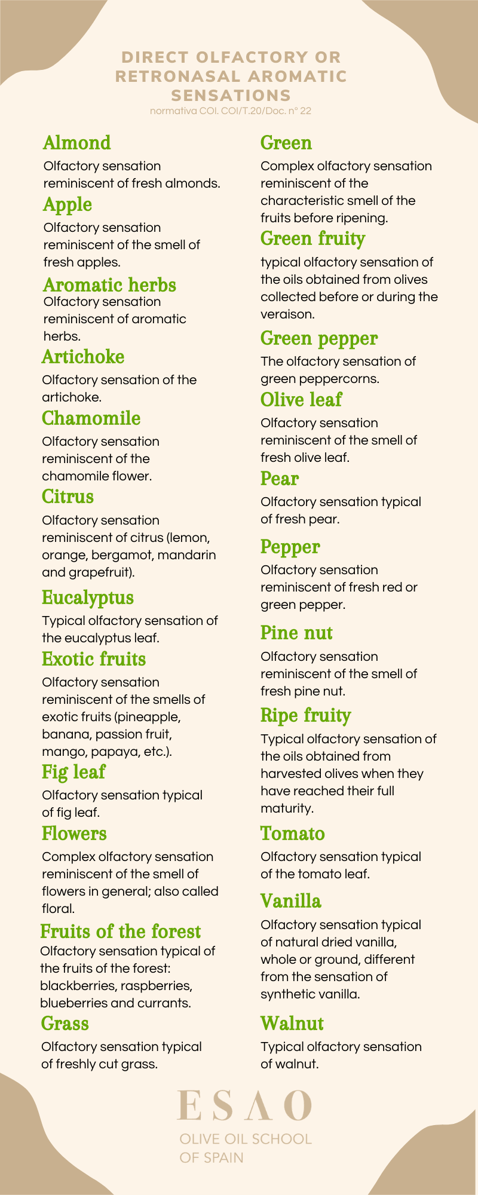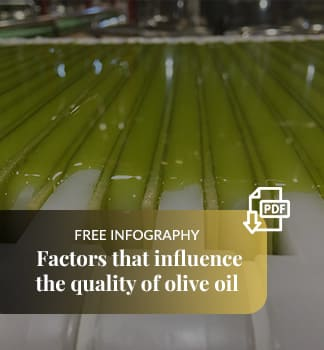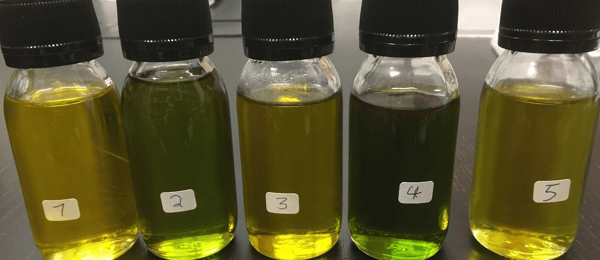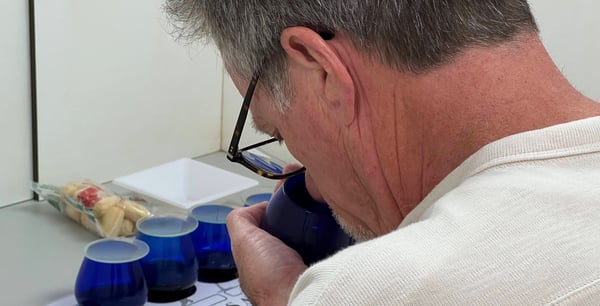Listen to this article
First of all, we are going to differentiate a Virgin Olive Oil tasting from a Virgin Olive Oil tasting course.
An olive oil tasting is an activity and specific experience, where depending on the type of tasting we select we will learn some things or others.
An olive oil tasting course is something else different. When we talk about a virgin olive oil tasting course at ESAO, what we want is for the student to enter the olive sector, understanding something beyond pure sensory analysis.
Aspects to work
In the olive oil tasting course we will learn to work on different aspects:
Olive varieties
We would not understand the knowledge in organoleptic work if we did not relate it, for example, to olive varieties.
There are a multitude of olive varieties, around 800, that have passed molecular markers and have been identified in the corresponding germplasm bank. This does not mean that there are not many more, since, indeed, there are, waiting to be properly identified and cataloged.
In the tasting course you can learn concepts about the most important or common olive varieties. In this way we will begin to better understand the nuances, aromas, flavors, bitter, spicy that we find depending on what oil samples we have in front of us.
ESAO Image Bank
Utensils needed for an olive oil tasting
Knowing the materials necessary for the virgin olive oil tasting, understanding the reason for the official tasting glass and the watch glass, are of great importance if you want to enjoy and make the most of a tasting.
Knowing the ideal amount of oil to put in the tasting glass, knowing what the ideal temperature is as well as the sufficient amount that you have to swallow, are part of the necessary training to be able to later interpret the aromas and flavors with which you you find.
Official olive oil tasting glasses. ESAO Image Bank
Registered as accessories for an official olive oil tasting in COI Standard COI / T.20 / Doc. IOC No. 22, International Olive Council:
- Standard glasses where the sample will be contained, coded, covered with a watch
- glass and kept at 28ºC + 2ºC
- profile sheet (Figure 1 of the method) on paper or computer support
- pencil or pen
- tray with apple slices
- glass of water at room temperature
Different olive oil scoring sheets
In the Virgin Olive Oil tasting course, one of the first subjects that you will encounter is knowing how to differentiate between the ESAO sensory sheet and the IOC profile sheet.
In the sensory card you will have the opportunity to learn to analyze and describe each of the notes and characteristics of virgin olive oil. From working with the intensity of the fruity, bitter and spicy, as well as describing in which family of aromas the sample is found, to refining in terms and analysis of complexity, harmony and persistence to finally approach the classification of the sample of in question.
In the COI profile sheet, only the absence or presence and intensity of the defect are scored and evaluated, as well as the intensity of fruity, bitter and spicy. With these parameters, the official classification tasting will tell you if you are dealing with an Extra Virgin Olive Oil, a virgin olive oil or a lampante virgin olive oil.
Recognize defects
We will learn what defects are and how to recognize them. In an Olive Oil tasting, surely at some point you will work with terms such as vinegary, runny or rancid and you may identify them.
In the oil tasting course you will work on each of the negative attributes or defects that are present in the oil, and you will be given a series of guidelines for you to differentiate and identify them.
Knowing where each of the defects comes from helps to enter the world of tasting in a more professional way, since knowing where the defects come from, we will be able to detect which are the critical points or weaknesses in the production or commercialization process and which have been responsible for these anomalies.
Five are the defects today characterized in olive oil by the IOC and these are the decayed, the vinegary, the mold, the damp wood and the rancid.
Different samples of olive oil. ESAO Image Bank
Descriptors
In the Virgin Olive Oil tasting course, you will become familiar with the most important descriptors, you will be able to name those sensations and perceptions that you will come across.
Different descriptor foods. ESAO Image Bank
Descriptors are those terms that we all use most frequently to address certain aromas. Descriptors are the keywords that help us to decipher the content we want to explain and in this way combine the meanings. It is about the specific names that we can give to aromatic sensations and perceptions, in order to have a common word to describe it. Below, as an example, you have an infographic with the list of descriptors registered in the COI / T.20 / Doc. IOC No. 22:

Olive Oil Descriptors infographics. ESAO Image Bank
Differentiate bitter and spicy
One of the tasks in the tasting course is to differentiate between bitter and spicy.
We know that bitter and spicy are positive attributes of olive oil, since they are directly associated with the phenolic composition and antioxidants, but it is important to see that it is not convenient to have bitter and spicy too aggressive, since they may not be well tolerated by some cultures or consumers.
Olive oil tasting session. ESAO Image Bank
Once you've gotten into the positive and negative attributes, it's time to start sensory analysis.
Tasting protocol and technique
In the oil tasting course you will see the importance given to the protocol and the tasting technique.
Mornings for example are the best hours for tasting, tasting olive oil just after eating is the least recommended time for tasting, especially if you are interested in differentiating and detecting characteristics.
Olive oil tasting session. ESAO Image Bank
Tasting always in the same place will help us to ensure that our training takes place in the best possible conditions.
One of the rules that will be most influenced in an oil tasting course is to be focused and not be influenced. Sometimes we are not able to remove the taster that we carry inside, because we are aware or influenced by the partner that we have next to us, or by a professional who directs the tasting and demands that we accept only what he tells us.
Olive oil tasting session. ESAO Image Bank
These concepts are of special importance in a tasting course. In fact, tastings with underage assistants are very enriching at the descriptor level, since they do not have that adult fear of being wrong, they let themselves be carried away and take more advantage of the descriptors in terms of detecting those that they really appreciate or do not know.
As important as the above, in the tasting course you will learn the importance of what saturation means, and that is why you must always have the samples controlled in time and quantity. There are tastings in which they put a number of samples, of which it is not possible to distinguish nuances, and sensory saturation invades us.
In a tasting course, the samples must be properly controlled, both in time and in stimuli. A student who is not an expert taster, it is easy that with three samples in a row he already has difficulties in differentiating them, especially if these differences are not very obvious.
Knowing how to rest between samples and dedicate the attention that each one needs is of great importance, since learning in tasting is slow and repetitive.
We will learn to know each others as tasters
We will know what our greatest difficulties are and where we have to influence. We will see if we have more facility to identify and recognize some defects than others, in order to be able to study more those that we have as weaknesses.
We will have the opportunity to get to know each other, because with each chapter we will do a kind of survey where you will have to answer the most important points of the chapter in question, and, in this way, you will be able to influence what has not been so clear to you and you will be able to evaluate you.
As in addition, throughout the course you are accompanied by a tasting professional, you will have the opportunity to ask any questions and understand concepts that may be complex for you.
You will learn to enjoy and get the most out of your olive oils
The more you learn about tasting and the more training you do in tasting, the more you will be able to enjoy extra virgin olive oil, the more you will be able to detect subtleties and nuances that will make you get the most out of your goals.
Olive oil tasting session. ESAO Image Bank
Whether it is an olive oil producer who wants to improve the quality of his oil or an olive oil professional who wants to buy oil, or a distributor who is going to select the olive oil brands he wants sell, or a final consumer who wants to enjoy and have access to good food, or as if it is a chef who wants to enrich his kitchen and his guests ... all these assumptions through training and olive oil tasting training, they will have more freedom to be able to select the quality that they wish to obtain at all times.
.png)
.png)





